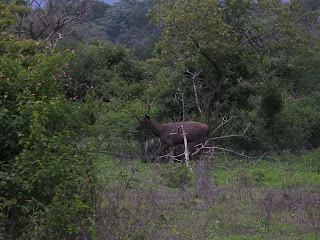Scientific name: Rusa unicolor
Conservation status: Vulnerable (Population decreasing)
Kingdom: Animalia
Gestation period: 246 days
Scientific name: Rusa unicolor
Conservation status: Vulnerable (Population decreasing)
Kingdom: Animalia
Gestation period: 246 days
Habits and Lifestyle
Sambars are mostly nocturnal and they rest during the day under the cover of heavy forest. They are solitary but sometimes form small groups during breeding seasons. Groups of 6 females or fewer, along with their dependent young may be seen traveling together.Young males form groups close to females, with males older then six years being typically solitary. Male animals are nomadic and will establish their territory primarily during the breeding season. They often gather near water, and they are good swimmers, being able to easily swim with their body fully submerged with only their head above water. Their senses are highly developed, which is of assistance in detecting predators.
When they perceive danger, they make a repetitive honking call.

Diet and Nutrition
Sambars are
herbivores, eating various grasses, foliage, fruits, leaves, water
plants, herbs, buds, berries, bamboo, stems and bark, as well as a wide
range of shrubs and trees.
Sambars are polygynous, one male mating with multiple females.
Males are very aggressive at the time of the breeding season. They guard their breeding territory and attract female deer by means of vocal displays and smell.

There is no specific breeding season, though it most commonly takes place between from September and January. Usually just one fawn is born, after a gestation period of about 9 months. Calves at birth are very active. Their hair is brown with lighter spots, which soon disappear.
They stay with their mothers for approximately 2 years.
Males are very aggressive at the time of the breeding season. They guard their breeding territory and attract female deer by means of vocal displays and smell.

There is no specific breeding season, though it most commonly takes place between from September and January. Usually just one fawn is born, after a gestation period of about 9 months. Calves at birth are very active. Their hair is brown with lighter spots, which soon disappear.
They stay with their mothers for approximately 2 years.







No comments:
Post a Comment